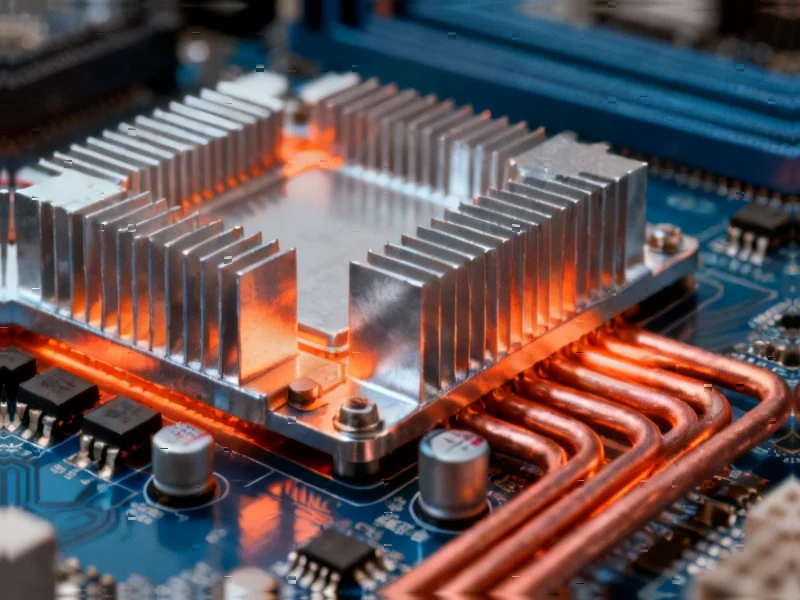The Hidden Thermal Threats in Your Computer
While much attention focuses on CPU and GPU temperatures, hardware analysts suggest several other critical components can cause system instability, performance degradation, and reduced lifespan when overheating. According to reports, neglecting these components’ thermal performance can lead to unexplained performance dips, data transfer slowdowns, and even hardware failure.
Table of Contents
Voltage Regulator Modules: The CPU’s Power Manager
Sources indicate that voltage regulator modules (VRMs) represent a significant thermal concern that many users overlook. The VRM converts high incoming voltage from the power supply into stable, lower voltage for the CPU, generating substantial heat through MOSFETs, capacitors, and chokes. Analysis suggests this heat can compound quickly under heavy loads, particularly when using precision boost overdrive or multicore enhancement settings.
The report states that inadequate VRM cooling can lead to CPU throttling, system instability, and potentially shortened motherboard component lifespan. Monitoring software like HWiNFO can track VRM temperatures if the motherboard includes the necessary sensors, though analysts note not all motherboards support this feature.
NVMe SSDs: Speed at a Thermal Cost
Modern NVMe SSDs, particularly Gen 4 and Gen 5 models, reportedly reach temperatures exceeding 70°C during sustained operations, according to component testing. Sources indicate that poor case airflow or placement behind GPUs where hot air accumulates can trigger built-in thermal throttling, dramatically reducing transfer speeds until cooling occurs.
Analysts suggest that since many users install operating systems on NVMe drives, thermal throttling can affect not just file transfers but also boot times, program launches, and general system responsiveness. Long-term exposure to high temperatures may degrade NAND flash cells and controllers, potentially risking data integrity. Monitoring tools like CrystalDiskInfo can help users track SSD temperatures and determine if aftermarket heatsinks are necessary.
DDR5 RAM: New Architecture, New Thermal Challenges
The shift to DDR5 memory has introduced new thermal considerations, reports indicate. Unlike previous generations, DDR5 incorporates voltage regulation directly within the DIMM through Power Management IC (PMIC), concentrating heat within the module itself. According to Corsair’s technical documentation, DDR5 modules typically operate between 0-95°C, but reaching upper temperature limits can cause memory training errors and instability.
Recent testing by TechPowerUp reportedly found that voltage, frequency, and CAS latency all influence DDR5 temperature rises, complicating the tuning process when thermal margins tighten. Most modern DDR5 kits include onboard thermal sensors accessible through motherboard software or HWiNFO, allowing real-time monitoring especially important for users employing XMP/EXPO profiles or overclocking., according to technology trends
Motherboard Chipset: The System’s Traffic Controller
The motherboard chipset, which manages data flow between CPU, RAM, storage, and peripheral devices, can become a significant heat source, according to component analysis. Modern chipsets handle traffic from high-speed NVMe drives, USB4 ports, and powerful GPUs while managing overclocking features that further impact temperatures.
Reports suggest that aging thermal pads or poor-quality thermal interface materials can cause unexpected temperature spikes in the chipset over time, potentially leading to sluggish USB performance, data transfer issues, and even CPU throttling. Many motherboard manufacturers now include small fans or passive heatsinks on chipsets, but analysts recommend monitoring temperatures through HWiNFO’s chipset category to identify potential cooling issues early.
A Holistic Approach to System Thermals
Hardware experts emphasize that thermal management requires a system-wide perspective beyond just CPU and GPU monitoring. While these four components don’t require constant surveillance, periodic temperature checks can help diagnose and troubleshoot performance issues before they escalate. According to analysts, understanding the complete thermal picture of your system can prevent stability problems, extend hardware lifespan, and maintain optimal performance across all computing tasks.
Related Articles You May Find Interesting
- Malaria Parasite’s Essential Trafficking Protein Reveals New Drug Target Potenti
- Brain Network Dynamics and Gene Expression Uncover Cognitive Challenges in Child
- TSMC’s 2nm Chip Pricing Strategy Threatens to Reshape Apple’s iPhone Economics
- This Compact Powerhouse Challenges Gaming Norms: AMD Ryzen 7 Mini PC Drops to Re
- Systemic Shock: How JLR’s £1.9bn Cyber Catastrophe Reveals UK Manufacturing’s Di
References & Further Reading
This article draws from multiple authoritative sources. For more information, please consult:
- https://www.hwinfo.com/
- https://crystalmark.info/en/download/#CrystalDiskInfo
- https://help.corsair.com/hc/en-us/articles/34383413781777-RAM-FAQ
- http://en.wikipedia.org/wiki/DDR5_SDRAM
- http://en.wikipedia.org/wiki/NVM_Express
- http://en.wikipedia.org/wiki/Motherboard
- http://en.wikipedia.org/wiki/Voltage
- http://en.wikipedia.org/wiki/Central_processing_unit
This article aggregates information from publicly available sources. All trademarks and copyrights belong to their respective owners.
Note: Featured image is for illustrative purposes only and does not represent any specific product, service, or entity mentioned in this article.



